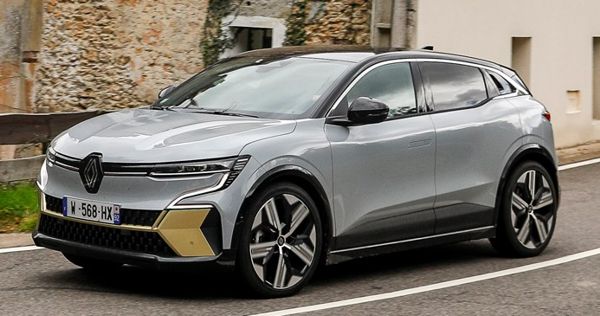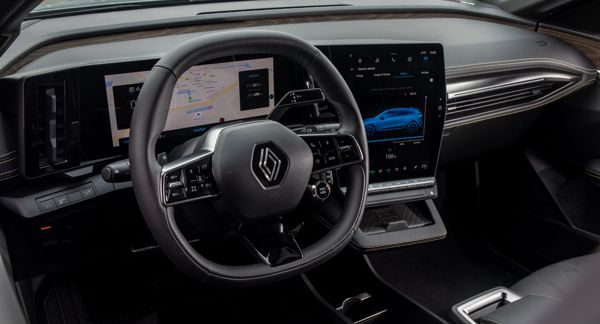Published
on 25
Nov 2021
|
All rights reserved.
|
|
|

|
|
Megane
V is turned into EV and a crossover alike.
|
|
History
will remember 2021 as the booming year of electric vehicles. Never
before so many car makers launch their first mass production electric
cars and trucks in a year. From this point, the motoring world will
start a rapid shift towards electrification and never look back. In
this year, we see the world debut of Lucid Air, Rivian R1, Mercedes EQS
and EQE, BMW iX and i4, Audi Q4 e-tron and E-tron GT, Hyundai Ioniq 5,
Kia EV6, Fiat 500 Electric, Ford Mustang Mach-E and F-150 Lightning,
GMC Hummer EV, Volkswagen ID.4, ID.5 and ID.6, Cupra Born, Skoda Enyaq,
Rimac Nevera, Pininfarina Battista…
Wait, what about Renault-Nissan alliance? The French-Japanese group
used to lead the EV world, being the first to mass produce affordable
EVs, even before Tesla. Somehow, Nissan Leaf, Renault Fluence Z.E. and
Zoe were born before battery technology matured enough to compete with
ICE cars. Today, a state of the art EV shall ride on a skateboard
platform with all batteries placed underneath the flat floor, shall be
modular and flexible enough to be derived into different sizes and
applications, shall support high-power quick charging that was simply
not available a few years back. Renault-Nissan might be the first to
produce affordable EVs in meaningful numbers, but they were too
conservative, failing to set any industrial standards or make any
breakthroughs in either battery technology or EV architecture.
Consequently, the last decade was largely wasted.
Fortunately, they are finally waking up. Both
the new Nissan Ariya and
Renault Megane E-Tech Electric are built on the company’s brand new
skateboard platform called CMF-EV. They support 130kW DC quick
charging, which should get the battery from depleted to 80% full in
half an hour. While the Nissan is designed as an SUV crossover, the
Renault will replace the existing Megane hatchback sometime next year,
although the old car will be sold alongside until 2024 to take care of
budget buyers.

|
|
At
1500mm, it is only 53mm taller than the old Megane.
|
|
To take advantage of the market fever of crossovers, Renault design
boss Laurens van den Acker deliberately styled it like a crossover,
thanks to a high waistline, larger ground clearance and 20-inch wheels.
However, I would say it is actually a hatchback, because its 1500mm
height is just 53mm taller than the old Megane. The styling is very
well done, especially the nose which is sleek, classy and unique. Gold
blades added to the bumper intake are smart touches. Shallow side glass
and hidden rear door handles contribute to a sportier appearance, but
overall this is a sleek and very refined piece of design. Nevertheless,
considering its sleek look, the drag coefficient of 0.29 could be
better.
The crossover look is deliberate, but it is also the result of the
skateboard platform. Until now, only Tesla and Lucid managed to make
their cars just as low as conventional ones. While Renault said its
skateboard floorpan is the thinnest in the industry at 110mm, it might
have forgotten Tesla Model S is even thinner at 100mm. The seating
position of the new Megane is certainly raised, if not as high as a
real crossover. Headroom is normal by hatchback standards, rear legroom
is quite generous, thanks to the 2700mm wheelbase, which is 30mm longer
than today’s Megane. However, as the seat is mounted relatively close
to the raised floor and the floor is not sculpted, foot room under the
front seats is in short supply. Still, the electric Megane is more
space efficient than its fuel-powered predecessor. You won’t notice
that its exterior is 150mm shorter and 45mm narrower than before from
the cabin.
On the contrary, you will appreciate that its flat floor enables the
5th passenger to sit happily. Its 440-liter boot easily trumps a
conventional family hatch, even though there is no front boot or
“frunk”.

|
|
Materials
are good enough to shame VW ID.3.
|
|
On the preproduction prototype, the driving environment feels positive.
The view out is not exactly expansive, especially through the shallow
rear screen, but the cabin is trimmed with materials which feel good
enough to shame Volkswagen ID.3. Top spec. model has synthetic leather
trims on dashboard and wood finish at door panels. The L-shape display
panel combines a 12.3-inch instrument display and a portrait
infotainment screen that measures either 8-inch or 12-inch. While its
graphic is not the sharpest, it is powered by Google, responds quickly
to input and provides a very good voice recognition. Moreover, physical
buttons are left beneath the touchscreen for easy control of air-con.
Unlike many other EVs, the Megane E-Tech is front-wheel drive only,
with the electric motor mounted up front like a conventional hatchback.
You may choose between two motors: 130 horsepower and 184 lbft of
torque, or 218 horsepower and 221 lbft of torque. The latter is good
for 0-60 mph in 7 seconds dead, more than quick enough for a family
hatchback. Top speed is regulated at 99 mph, same as VW ID.3.
Likewise, there are 2 battery options: 40 kWh for 130 hp motor, or 60
kWh for 218 hp motor. They are good for 300km (186 miles) or 470km (293
miles) WLTP range, respectively. The larger battery weighs 395 kg,
helping the car to achieve a center of gravity 90mm lower than the
current Megane.
The LG Chem battery is made of lithium NMC
like Nissan Leaf or Renault
Zoe, but the chemistry has been revised such that it employs more
nickel and less cobalt, reducing not only costs but also environmental
harms. Meanwhile, the electrically excited synchronous motor does not
employ any rare earth, unlike the permanent magnet motors found on most
rivals. Although an excited motor is slightly less energy efficient
than permanent magnet one, getting rid of rare earth is good for
environmental protection. Moreover, this will free Renault-Nissan from
the supply threat of rare earth, currently dominated by one country.

|
|
Renault
has potentially the best affordable C-segment EV on the market. Elon
Musk and VW should be jealous.
|
|
The electric Megane does not set any standards in any particular area,
but strangely, all things come together to make a good driving
experience. For an EV, the top spec. 60kWh model is remarkably light at
1624 kg – that’s nearly 100kg less than the 58kWh ID.3. It is nice to
see Renault paid attention to weight saving, trimming weight from the
battery, motor, HVAC and body (it uses aluminum doors). Thanks to such
efforts, as well as the car’s lower center of gravity, it feels not
only quick in acceleration but also agile in corner. The steering is
light yet quick. The nose turns in eagerly. The car corners flatly.
There is good level of grip and stability, too. Only the inconsistent
braking and some wheel spin in tight corner need more work, but Renault
still has time to sort it out before it goes on sale next Q3.
More remarkable is, while it steers and handles very well, it provides
a comfortable ride simultaneously. Expansion joints and large bumps are
easily dealt with. Perhaps because the car is relatively light, it does
not need very stiff springs to handle its mass. Even on 20-inch wheels,
the car rides with a supple manner rarely found on electric cars.
Another surprise is energy management. In real-world driving, the car’s
driving range is remarkably close to its advertised number. This means
a 60kWh Megane might rival a VW ID.3 with 77kWh battery, saving a lot
of money.
Now Renault has potentially the best affordable C-segment EV on the
market, something Elon Musk dreamed for but found no way to realize,
something Volkswagen aimed at with ID.3 but failed to materialize.
|
Verdict:    
|
|